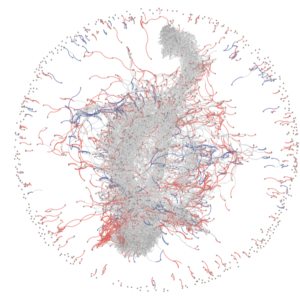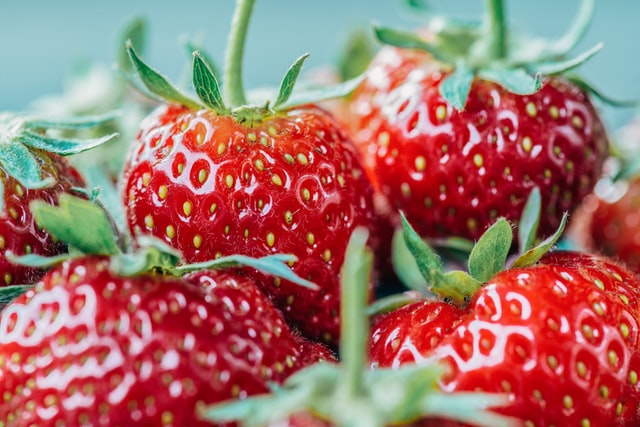Geneticists dig up the dirt on 300 years of succulence.
When Steve Knapp started his new job at the University of California, Davis, he plunged into a forensic mystery that would take years to unravel. He wasn’t hunting a criminal or identifying a missing person, but the challenge before him was just as formidable: reconstructing the genetic identity of more than one thousand strawberry plants owned by the university. In the end, the strawberry genealogy would expand to include over 8,000 individuals around the world.
Knapp is director of the Strawberry Breeding Program at UC Davis. The humble strawberry, that ubiquitous staple of summer picnics, represents big business for the University of California. Strawberries bred at UC Davis account for around half of California’s $2.6 billion annual crop. “In the entire UC system, for many years, it was the top royalty generator,” said Knapp. While pharmaceuticals have now taken the lead, licensing fees from the berries still bring in more than $7 million a year.
UC Davis hired Knapp in 2015 to restore confidence in their strawberry breeding program after the previous director left to start his own private breeding company. Fearing the program would be shuttered, the California Strawberry Commission (CSC) sued the school. Knapp was brought on board as part of the university’s settlement with the CSC, reinforcing the program’s commitment to continue producing new strawberry varieties.
Knapp faced a massive challenge. To successfully breed the plants, he had to know what the program’s historic collection contained, but some 95% of the pedigree records were missing. With around 1,500 specimens and sparse records, he and his team would need to draw on a combination of molecular genetic techniques and old-fashioned genealogical detective work to document the collection.
Now published in G3: Genes|Genomes|Genetics, this huge curation project also explored the tangled roots of today’s strawberries. Modern varieties were first created in 18th century France from spontaneous crosses between the Chilean strawberry and another New World import, the Virginian strawberry. After the mysterious parentage of these cultivars was uncovered by a teenage botanist working in the palace gardens of Versailles, horticulturalists developed the fruit into the large berries recognizable to shoppers today.
But this long-told origin story glosses over the true complexity of the modern strawberry’s ancestry. Over the years, breeders intensively crossed, back-crossed, and selected countless varieties from across the world, repeatedly introducing various wild species into the mix. The genetic twists and turns of strawberry domestication are still not fully understood.
To map the relationships between specimens in the university collection, the team used high-density single nucleotide polymorphism (SNP) genotype analysis. They genotyped every individual plant in the collection and applied statistical analyses to establish parent-offspring relationships. The pedigrees that they generated—replete with long-lived individuals, overlapping generations, and extensive hybridization—became too large and complex for conventional pedigree visualization software, so the researchers turned to tools for social network analysis to identify patterns and relationships between the plants. This method enabled them to visualize the diversity of individual plants that have “founded” domesticated populations over the 300-year history of strawberry cultivation.

To delve beyond the Davis collection, Knapp posed a challenge to the members of his lab. “I said, it would be really cool to connect this UC material to the founders that created it,” he said. “Where did that material come from?”
Graduate student Dominique Pincot sank her teeth into the project. She followed the paper trail to the University of Utah, where she found a set of notebooks containing pedigrees recorded by Royce Bringhurst, “Mr. Strawberry,” who headed the UC Davis program from 1952 to 1989.
Next, the team tracked down pre-WWII pedigrees from the UC collection that had made their way to Driscoll Strawberry Associates, the commercial berry seller. “We literally had these three-ring binders full of crusty old notes of pedigrees that gave us a pretty good reconstruction all the way back to the early Berkeley days,” Knapp said.
Each new thread led to another set of records, and Pincot continued tracing various lineages back through North American and European records and catalogs. The project amassed over 800 sources of data documenting the genealogy of today’s strawberry varieties, and the pedigree encompassed 8,851 individual plants.
“We eventually translated this from this massive legal battle into a labor of love,” Knapp said. “It became extremely fun for us.”
Besides the practical benefit to the UC Davis breeding program, the strawberry genealogy project provides broader scientific benefits. Understanding how modern strawberry genetics relates to earlier varieties is informative because agricultural cultivation often reduces genetic variation within a species. Ultimately a lack of diversity from too much inbreeding can harm the health of the species as well as limiting the options for introducing new traits. Knapp’s analysis revealed that although more than 80% of ancestor strawberries are now extinct, the modern strawberries have retained a great deal of genetic diversity from those ancestors.
Additionally, the project shed light on the breeding speed of the strawberry, or the number of years between generations. “We showed that the breeding cycle was fairly long,” said Knapp. “We made the argument that genetic gains can be increased by speeding it up.” The breeding cycle has decreased over the last 200 years from nearly 17 years per generation down to about six. Faster breeding times would enable the introduction of more genetic variation.
Having this genealogical information to hand has already enabled new kinds of strawberry genomic analysis and tool development. It also advances predictive breeding, a method that uses genetic information to forecast which offspring will have desired traits. “This project was meant to tell us, how did we get here and where have we been, and how can we use this information to predict the future,” said Knapp.
CITATION
Social network analysis of the genealogy of strawberry: retracing the wild roots of heirloom and modern cultivars
Dominique D A Pincot, Mirko Ledda, Mitchell J Feldmann, Michael A Hardigan, Thomas J Poorten, Daniel E Runcie, Christopher Heffelfinger, Stephen L Dellaporta, Glenn S Cole, Steven J Knapp
G3 Genes|Genomes|Genetics, Volume 11, Issue 3, March 2021, jkab015, https://doi.org/10.1093/g3journal/jkab015













